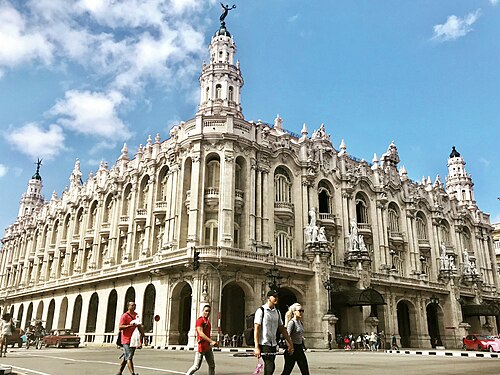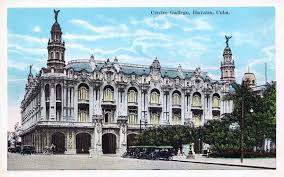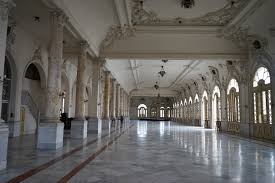
EL CENTRO GALLEGO, LA HABANA, CUBA, HOY EL GRAN TEATRO DE LA HABANA. FOTOS.
El Centro Gallego de La Habana. En el corazón de La Habana, en el Paseo del Prado (José Martí), frente al Parque Central y ubicado entre el Capitolio y el histórico Hotel Inglaterra, se alza majestuoso e imponente el Centro Gallego de La Habana. Su construcción fue financiada por los inmigrantes gallegos de La Habana para servir como centro comunitario-social. Tras el triunfo de la Revolución Castro en 1959, fue confiscado.
Entre los lugares de interés histórico del Paseo del Prado se encuentra la manzana baja entre San José y San Rafael, entre el Capitolio y el Hotel Inglaterra. En ese sitio se inauguró el 15 de abril de 1838 el teatro más importante de la capital y uno de los más grandes del continente, El Tacón, y en 1914 se construyó el Palacio del Centro Gallego de La Habana. Obra del arquitecto belga Paul Beleu, de estilo neobarroco, su fachada principal cuenta con cuatro esculturas de mármol blanco que representan alegorías de la caridad, la educación, la música y el teatro, diseñadas por Giuseppe Moretti. Los elementos se colocaron de forma equilibrada: balcones, ventanas, cornisas, la proporción de sus torres y los elementos decorativos lograron un ritmo elegante. Su teatro se construyó en el hermoso edificio y durante muchos años fue el más grande y lujoso de Cuba.
Desde su creación en 1880, sus prioridades se hicieron evidentes, pues nació con tres secciones: “Recreación y Adorno”, “Declamación” e “Instrucción”, esta última a cargo de una escuela de educación general, lengua y biblioteca que ya atendía a 109 estudiantes en 1881, a pesar de contar con solo 701 socios. Pronto creó una sección “Lírica” y otra “Filarmónica” con folclore comprometido, y se hizo cargo de lo que quedaba del coro “Ecos de Galicia”. En 1907 se colocó la primera piedra del edificio. En 1913, se finalizaron las obras del Teatro del Palacio Social y en 1915 se concluyó. Para entonces, se mantenía el nombre de “Campus Concepción Arenal”, que abarcaba clases de primaria y clases nocturnas de costura, oficios, taquigrafía, etc. También contaba con una “Academia de Bellas Artes” y una “Academia de Música”, elevada a Conservatorio Nacional.
DESPUÉS DE LA REVOLUCIÓN DE 1959
Tras el triunfo del proceso revolucionario de 1959, el Centro Gallego y otros edificios construidos con el esfuerzo y la contribución de los españoles emigrados a Cuba fueron confiscados y convertidos en organizaciones culturales nacionales.
El Centro Gallego pasó a estar bajo la administración de Alicia Alonso con el nombre de Gran Teatro de Ballet y Ópera de Cuba. En 1978, el teatro, remodelado con motivo de la celebración en Cuba del XI Festival Mundial de la Juventud y los Estudiantes, tenía un aforo de 1556 butacas.
Actualmente, su principal sede es el Auditorio García Lorca, con capacidad para 1500 personas. Este espacio alberga al Ballet Nacional de Cuba, así como a otras compañías de danza y espectáculos musicales. Durante los siglos XIX y XX, se presentaron en su escenario artistas como Ole Bull, Enrico Caruso, Fanny Elssler, Jenny Lind, Anna Pavlova, Antonia Mercé, Ruth Saint Denis, Ted Shawn, Teresa Carreño, Vicente Escudero, Maya Plisetskaya, Clorinda Corradi, Sarah Bernhardt, Carla Fracci y Alicia Alonso, además de compañías como el American Ballet Theatre, el Royal Winnipeg Ballet, el ballet de Antonio Gades, el Ballet del Teatro Colón de Buenos Aires, el Ballet Folclórico de México y otras compañías de ballet.

THE GALICIAN CENTER, HAVANA, CUBA, TODAY THE GRAND THEATRE OF HAVANA. PHOTOS.
The Galician Center of Havana. In the heart of Havana, on the Paseo del Prado (José Martí), opposite Central Park and located between the Capitol and the historic Hotel Inglaterra, stands majestic and imposing the Galician Center of Havana. Its construction was paid for by the Galician immigrants of Havana to serve as a community-social center. At the triumph of the Castro Revolution in 1959 it was confiscated.
Among the places of historical content of the Paseo del Prado, is the fall block between San Jose and San Rafael, between the Capitol and the Hotel Inglaterra. On that site was inaugurated on April 15, 1838 the most important theater in the capital and one of the largest on the continent, El Tacón, and in 1914 was built on the whole apple’s palace Galician Center of Havana. Work of the Belgian architect Paul Beleu and was built in neo-baroque style, its main facade has 4 white marble sculptures representing allegories of charity, education, music and theater, designed by Giuseppe Moretti. The items were placed in a balanced way, balconies, windows, cornices, the proportion of its towers and trim unit achieved an elegant pace. His theater was built in the beautiful building and for many years was the largest and most luxurious in Cuba.
Since its inception in 1880 hinted its priorities, because she was born with 3 sections: “Recreation and Adorno”, “Declamation” and “Instruction”, the latter in charge of a school of general education, language and library that already took care of 109 students in 1881 despite having just 701 Center partners. He soon created a section “Lyric” and another “Philharmonic” with committed folk and took over what was left of the choir “Ecos de Galicia”. In 1907 the foundation stone of the building-seat was placed. In 1913, work was completed on the Social Palace Theatre and in 1915 was concluded. By now kept called “Campus Concepción Arenal” covering primary classes and evening classes in sewing, trade, shorthand, etc. Also maintained a “Academia de Bellas Artes” and “Music Academy” elevated to National Conservatory.

AFTER THE 1959 REVOLUTION
After the triumph of the revolutionary process of 1959 the Galician Center and other buildings built with the effort and contribution by the Spaniards emigrated in Cuba were confiscated and converted into national organizations, culture.
The Galician Center went under the administration of Alicia Alonso with the name of Grand Theater Ballet and Opera de Cuba. In 1978, the theater, revamped again on the occasion of the celebration in Cuba of the XI World Festival of Youth and Students, had a capacity of 1556 seats.
Currently, the principal venue is the García Lorca Auditorium, with seats for 1,500 persons, it provides a home for the Cuban National Ballet Company, and for other dance companies and musical performances. During the 19th and 20th century, performances that took place on its stage include: Ole Bull, Enrico Caruso, Fanny Elssler, Jenny Lind, Anna Pavlova, Antonia Mercé, Ruth Saint Denis, Ted Shawn, Teresa Carreño, Vicente Escudero, Maya Plisetskaya, Clorinda Corradi, Sarah Bernhardt, Carla Fracci and Alicia Alonso, as well as companies such as the American Ballet Theatre, the Royal Winnipeg Ballet, Antonio Gades ballet, the Ballet of the Colón Theatre of Buenos Aires, the Ballet Folclórico of Mexico, plus other ballet companies.

Agencies/ Wikipedia/ Internet Photos/ CubaHoy/ Arnoldo Varona/ www.thecubanhistory.com
THE CUBAN HISTORY, HOLLYWOOD.





 EL CENTRO GALLEGO, LA HABANA, CUBA, HOY EL GRAN TEATRO DE LA HABANA. PHOTOS. * THE GALICIAN CENTER, HAVANA, CUBA, TODAY THE GRAND THEATRE OF HAVANA. PHOTOS.
EL CENTRO GALLEGO, LA HABANA, CUBA, HOY EL GRAN TEATRO DE LA HABANA. PHOTOS. * THE GALICIAN CENTER, HAVANA, CUBA, TODAY THE GRAND THEATRE OF HAVANA. PHOTOS.